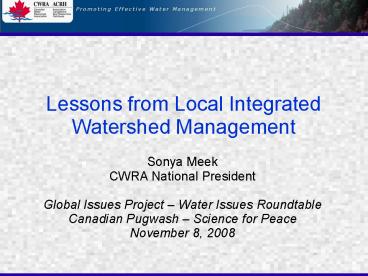Lessons from Local Integrated Watershed Management - PowerPoint PPT Presentation
1 / 11
Title:
Lessons from Local Integrated Watershed Management
Description:
Lessons from Local Integrated Watershed Management. Sonya Meek. CWRA National President. Global Issues Project Water Issues Roundtable. Canadian Pugwash ... – PowerPoint PPT presentation
Number of Views:37
Avg rating:3.0/5.0
Title: Lessons from Local Integrated Watershed Management
1
Lessons from Local Integrated Watershed Management
- Sonya Meek
- CWRA National President
- Global Issues Project Water Issues Roundtable
- Canadian Pugwash Science for Peace
- November 8, 2008
2
Case 1 Rouge River Watershed Plan
- Led by multi-stakeholder task force
- Interdisciplinary analysis of future scenarios at
all scales on watershed basis - Strategic recommendations to guide sustainable
urban growth and watershed regeneration - Approved March 2008 and its already being
implemented by many partners
3
Case 2 Partners in Project Green A Pearson
Eco-business Zone
- 12,000 ha of employment lands
- 12,000 businesses
- 350,000 employed in area (Canadas largest
employment area) - 5.8 million MWh of electricity-use (1/26th of
Ontarios consumption) - 46.5 million GJ of natural gas use
- 108.5 million m3 of water consumption
- 1.7 million tonnes of GHGs
- Targets
- 20 energy reduction (2015)
- 10 of buildings green retrofit (2015)
- 10 renewable energy generation (2015)
- 15 per capita (2025) (Peel)
4
Case 2 contd Partners in Project Green
Programs and Projects
- One-Window Eco-Efficiency Audit (free assessment,
cost-shared audit and implementation assistance) - Green Building Retrofit (assistance on
retrofitting multiple buildings) - Waste Re-Utilization Network (facilitating waste
exchange opportunities) - Green Purchasing Blocks (multi-business
procurement of green technologies) - Airport District Energy System (undertaking
feasibility assessment of district energy
opportunities) - Green Parking Lot Program (cost shared re-design
of landscaped and parking areas) - Green Job Development (Green Job Corp. Green
Business Retention Strategy)
5
Lesson 1 IWM is effective and could be used
elsewhere to achieve cooperative solutions.
- A few reasons why its effective
- Inclusive, shared decision-making (vs. top down)
- Common vision and goals
- Implementers are involved
- Watershed is a manageable scale
- Integrated more creative solutions
- Fosters shift toward demand management,
stewardship ethic, culture of conservation - Fosters local champions
6
Implications for a Canadian National Water
Strategy (CNWS)
- Despite instances of local leadership, there is
not always the capacity or full participation by
all key players in all regions of Canada. - There is a need for a Canada-wide strategy that
can facilitate effective leadership at all
scales. - A CNWS could help clarify roles, address gaps in
capacity and provide consistency among regions - A CNWS could ensure effective responses to
current and emerging challenges and threats
common across Canada.
7
Lesson 2 Principles of IWM could be followed
in the development of an effective CNWS
- Participation by all stakeholders
- Commonly endorsed goals and principles
- Specific commitments to action on key areas
- Able to evolve and adapt
- Mechanism to track implementation progress
- Builds on existing governance structures
8
Proposed Process for Development of a CNWS
Leadership Team Formation
Discussion Paper
Consensus Building Workshops
Strategy Development
9
Sectoral Representation in Leadership Team
- International
- Federal
- Aboriginal
- Provincial
- Local government
- Water users
- Water related NGOs
10
Summary 3 Lessons
- The IWM approach has the potential to be used
elsewhere for achieving cooperative solutions to
water management issues - A CNWS could facilitate the practice of local
integrated watershed management (IWM) in Canada
Principles of IWM could be used in the process to
develop an effective CNWS. - Although Canada is not the first country to
develop a national water strategy, a CNWS and the
process followed to develop it can be a model for
cooperation in other diverse regions.
11
www.cwra.org Sonya Meek CWRA National
President smeek_at_trca.on.ca






























